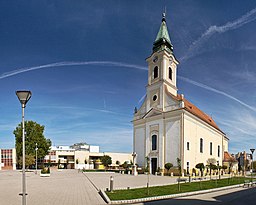Bánovce nad Bebravou
| Bánovce nad Bebravou | ||
| Town | ||
|
A church in Bánovce nad Bebravou
|
||
|
||
| Country | Slovakia | |
|---|---|---|
| Region | Trenčín | |
| District | Bánovce nad Bebravou | |
| River | Bebrava | |
| Elevation | 216 m (709 ft) | |
| Coordinates | 48°43′07″N 18°15′29″E / 48.71861°N 18.25806°ECoordinates: 48°43′07″N 18°15′29″E / 48.71861°N 18.25806°E | |
| Area | 26.459 km2 (10.216 sq mi) | |
| Population | 20,639 (2005) | |
| Density | 780/km2 (2,020/sq mi) | |
| First mentioned | 1232 | |
| Mayor | Marián Chovanec | |
| Timezone | CET (UTC+1) | |
| - summer (DST) | CEST (UTC+2) | |
| Postal code | 957 01 | |
| Area code | +421-38 | |
| Car plate | BN | |
| Statistics: MOŠ/MIS | ||
| Website: Banovce.sk | ||
Bánovce nad Bebravou (German: Banowitz, Hungarian: Bán) is a town in Slovakia, in the Trenčín Region.
The name is derived from the personal name or title Bán meaning "the village of Bán's people". "Nad Bebravou" means "above Bebrava" (beaver river). The eldest inscription mentioning the town as villa Ben dates back to 1232. Other recorded names are Villa Ban (1318), Banowitz (1389), opidum Banowcz (1439), Ban (1467), Banowcze (1471).
It is located at the northernmost edge of the Danubian Hills, at the foothills of the Strážovské vrchy mountains at the confluence of the Radiša and Bebrava rivers. It is 25 km away from Prievidza, 30 km from Trenčín and 50 km from Nitra.
The oldest settlement stems from the Bronze Age. The town was promoted in 1376 into free royal town (until 1389, then landlord township). In the Middle Ages, Bánovce became an important trade centre - for shoemakers, carpenters, smiths, butchers, weavers and others. In 1633, the Ottomans encroaching from the south plundered the town. The first elementary school was opened in the 17th century. During the first Czechoslovak republic, it was an agricultural-crafting town. During World War II, the town was taken by Romanian troops of the 1st Army on 5 April 1945. After World War II, automobile, furniture and textile industries developed.
In total, there are 15 cultural memorials in the town and its boroughs inscribed in the central inventory of culture memorials in Bratislava.
...
Wikipedia






